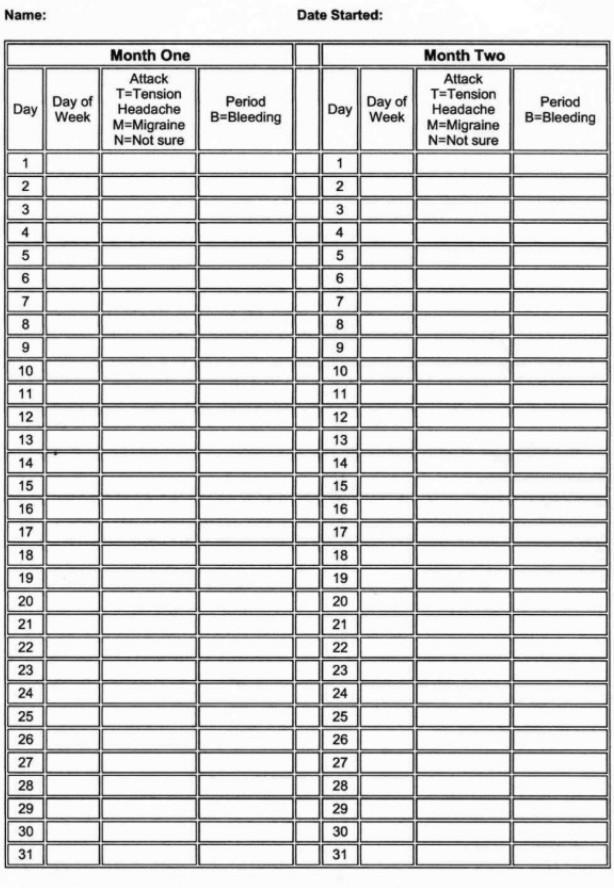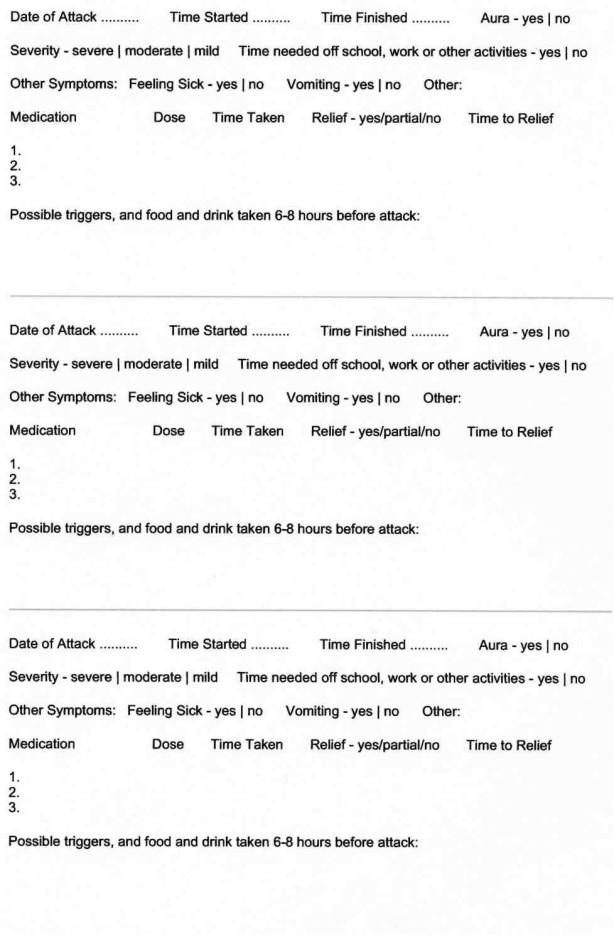
Migraine trigger diary
Peer reviewed by Dr Sarah Jarvis MBE, FRCGPLast updated by Dr Hayley Willacy, FRCGP Last updated 11 Oct 2017
- DownloadDownload
- Share
This leaflet is about keeping a diary of your migraines to help identify what is causing them.
In this article:
Continue reading below
Why should I keep a migraine diary?
Most migraines seem to come right out of the blue, but for some people there are certain things that can set them off - we call these triggers. These can be all different types of things like food, your environment or mood, medicines and hormones. If you want to learn more about migraines and what can trigger them, read the migraine leaflet for more detail.
If you are trying to work out what is causing your migraines, it may help to keep a migraine diary. A pattern may emerge, and it may be possible to avoid one or more things that may trigger your migraines. But too much effort trying to identify triggers can make you very anxious. In some people it may do more harm than good, especially if no trigger is found - which is common.
Patient picks for Migraine

Brain and nerves
Should you avoid the pill if you get migraines?
For decades, migraine sufferers with aura have been told to avoid the combined oral contraceptive pill because of a slightly increased risk of stroke. But is this still the case? We ask experts about the latest guidance and what the best form of contraception is for those prone to migraines.
by Georgia Gallant

Brain and nerves
Migraine and combined hormonal contraception
If you have migraine with aura, you should not use combined hormonal contraceptives - which means the combined oral contraceptive (COC) pill ('the pill'), the contraceptive vaginal ring ("the ring") or the contraceptive patch ('the patch'). This is because of a small but significant increased risk of having a stroke. If you have migraine without aura you should not take combined hormonal contraceptives if you are aged 35 or older. If you previously never had migraine, and then develop any type of migraine (with or without aura) after starting combined hormonal contraceptives, you should stop using them. Some women aged under 35 who have migraine without aura are prescribed combined hormonal contraceptives. They then find that the pill-free, ring-free or patch-free break triggers migraine attacks. If this happens to you then you do not need to stop your combined hormonal contraceptive. Tips for you to reduce headache frequency are given below.
by Dr Hayley Willacy, FRCGP
What should I write in the diary?
Have a look at the example of a migraine diary below.
1) Fill in the calendar part. This gives an overall picture of when the migraines occur.
Fill in the days of the week.
Mark when you have an attack. Note: people with migraine can also have common tension-type headaches. So, in the attack column, indicate when you have a migraine, or a tension-type headache, or if you are not sure.
If you are a woman and have periods, put a B in the period column on the days you are bleeding.
2) Fill in a notes section for each attack. This gives details of:
How bad the attacks (episodes) are.
How well medication helps.
Possible factors that may have triggered the attack.
It may help to fill it in over 3-4 months so that you develop a better understanding of your migraines. You can share this with your doctor.
Continue reading below
Migraine/Headache Diary
Migraine diary one

Migraine diary two

Fill in the details of each migraine/headache attack using the following:
migraine notes

migraine notes

Article history
The information on this page is peer reviewed by qualified clinicians.
11 Oct 2017 | Latest version

Ask, share, connect.
Browse discussions, ask questions, and share experiences across hundreds of health topics.

Feeling unwell?
Assess your symptoms online for free